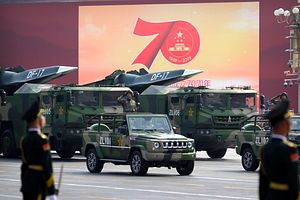By Ankit Panda
 In testimony before the U.S. Senate’s Committee on Armed Services last week, Admiral Charles A. Richard, the commander of U.S. Strategic Command, discussed a range of developments in the strategic nuclear forces of both Russia and China. “China continues to expand and increase its strategic force capabilities,” Richard observed in his prepared testimony.
In testimony before the U.S. Senate’s Committee on Armed Services last week, Admiral Charles A. Richard, the commander of U.S. Strategic Command, discussed a range of developments in the strategic nuclear forces of both Russia and China. “China continues to expand and increase its strategic force capabilities,” Richard observed in his prepared testimony.
Describing some of the modernized Chinese systems, Richard listed the Dong Feng 17 (DF-17), China’s first hypersonic boost-glide vehicle-equipped missile system, which was first revealed to the world publicly at the October 1, 2019, parade to mark the 70th anniversary of the founding of the People’s Republic.
“During the 70th Anniversary Parade in October 2019, the PLA unveiled new strategic nuclear systems, including the H-6N BADGER bomber, DF-41 intercontinental ballistic missile (ICBM), DF-17 medium-range ballistic missile, and improved submarine-launched ballistic missiles (SLBM),” Adm. Richard observed.
The inclusion of the DF-17 in a list of “strategic nuclear systems” raises some questions. At the October 1 parade, Chinese authoritative state media announcers explicitly described the DF-17 as a conventional system, making no mention of a nuclear role. The People’s Liberation Army Rocket Force is composed of a range of systems, including conventional missiles, strategic nuclear missiles, and a set of dual-capable missiles that are capable of delivering both conventional and nuclear warheads.
Right now, there is no indication from authoritative Chinese sources that the DF-17 would play a nuclear delivery role, or that it may be a dual-capable system like the DF-21 or the DF-26. As originally reported by The Diplomat in November 2018, the DF-17 was originally assessed by U.S. intelligence to be dual-capable.
Richard’s testimony suggests that this assessment persists in the United States. But what is curious is the listing of the DF-17 as a “strategic” system outright. Even if a system is nuclear-capable (or dual-capable) in an intelligence assessment, that does not imply that it has any assigned nuclear role in practice.
The ambiguity over the DF-17’s possible future nuclear role may become clearer in due time. There are certain reasons to discount Richard‘s inclusion of this system among other strategic nuclear weapons like the JL-2 SLBM and the DF-41. The DF-17 mock-ups seen at the October 1 parade, for instance, appeared to be smaller than known Chinese nuclear-capable re-entry vehicles.
Given China’s nuclear No First Use policy since 1964, Beijing is not known to have conducted significant development work on small nuclear weapons physics packages of the kind that would be suitable for a relatively smaller flight vehicle like the DF-17’s HGV.
Given this and the fact that China has presented the DF-17 as a conventional-only system, it would be prudent to remain skeptical of the notion that this system is designed to play a nuclear role. The ambiguity, however, suggests that it may be useful for the United States and China to seek out a broader conversation on strategic stability and for Beijing to generally practice greater transparency on matters related to its nuclear weapons programs.
Boost-glide weapons like the DF-17 are designed to boost to exoatmospheric altitudes with the aid of a ballistic missile booster before pulling down into the earth’s atmosphere where they might leverage aerodynamic drag at high altitudes to fly at low trajectories on the way to their targets. The DF-17 is thought to be a medium-range system, with a range between 1,800 and 2,500 kilometers.
The DF-17 was first flight-tested in November 2017.
No comments:
Post a Comment